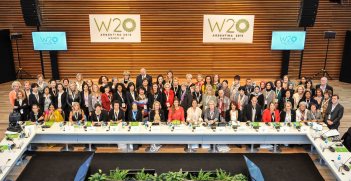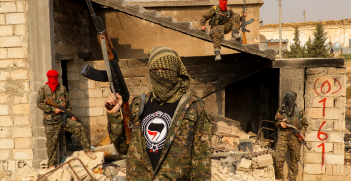The Impact of Coronavirus on Human Trafficking

Human traffickers swiftly adapted to border closures and other measures to curb the spread of the coronavirus. Meanwhile, victims have been exposed to further exploitation, with access to essential services restricted.
The United Nations defines human trafficking as:
The recruitment, transportation, transfer, harbouring or receipt of persons, by means of the threat or use of force or other forms of coercion, of abduction, of fraud, of deception, of the abuse of power or of a position of vulnerability or of the giving or receiving of payments or benefits to achieve the consent of a person having control over another person, for the purpose of exploitation.
According to World Vision, an estimated 21 million people are being trafficked around the world today. Men, women, and children are exploited for a wide range of purposes, including forced labour, sexual exploitation, domestic servitude, debt bondage, child soldiers, forced marriage, and organ harvesting. While trafficking for sexual exploitation is more commonly reported among women and girls, it can affect all ages and genders. Human trafficking is considered the second-largest source of illegal income behind the illicit drug trade. It is an estimated US$150 billion industry, with almost a third of profits generated in wealthy industrialised countries like Australia.
Approximately 28 percent of identified victims trafficked globally are children. Across regions such as Sub-Saharan Africa, Central America, and the Caribbean, children account for an even higher proportion of identified trafficking victims, at 64 and 62 percent, respectively. Refugee, migrant, and displaced children are especially vulnerable to trafficking. Whether they are escaping war and violence or pursuing better education and livelihood opportunities, too few children find pathways to move regularly and safely with their families. The lack of safe pathways increases the likelihood that families will turn to irregular and more dangerous routes, or that children will move on their own, leaving them more vulnerable to violence, abuse, and exploitation by traffickers.
Re-victimisation and Criminalisation
In many contexts, there is a lack of sustainable assistance, rehabilitation, and protection for child victims of trafficking. Many child protection systems remain under-resourced, and there is an acute lack of guardianship and other alternative care arrangements. Children are often placed in inadequate shelters where they risk further traumatisation and re-victimisation. Trafficked boys can face additional challenges, as gender stereotypes can prevent them from getting or seeking the help they need. At the same time, girls may also be at risk of further exploitation and abuse due to gender discrimination and gendered poverty.
The lack of sustainable solutions is also very prevalent for adult victims of trafficking. Adult victims face the same challenges as children, with the exception of a need for child protection systems. Adult victims of human trafficking are more likely to be re-victimised due to stigma surrounding the victims’ time being trafficked and the criminality that is forced upon the victims who engage in illegal activity such as sex work, fraudulence, or distributing of drugs or pornographic material. Forced participation in unlawful activity can lead to imprisonment and prosecution of the victims rather than the human traffickers themselves. The criminalisation of victims of human trafficking is one of the most significant factors that increases the risk of re-victimisation into human trafficking and victims’ reluctance to get help. Failure to understand the situation the trafficking victims were in and the lack of control that they had over their actions, beliefs based on gender stereotypes, and gender discrimination within the law and government systems prevents the creation of policies and provision of further legal help for victims.
Impact of Coronavirus
Although COVID-19 has stopped a lot of international travel and trade, the illegal human trafficking processes are still very much prevalent. Like the rest of the world, human traffickers have adapted to this changing situation. Although the use of technology and media is not a new method used by human traffickers, COVID-19 has furthered the use of technology and media and the reach of traffickers. According UN Women, as lockdowns have been enforced worldwide, there have been reports of increased grooming and exploitation of children online through gaming sites and social media platforms by sexual predators as children have had to stay home from school, and the demand for pornography has risen. International and national law enforcement agencies, including Europol and the United States Federal Bureau of Investigation, have put out warnings about the increasing risk of sexual exploitation on the Internet and signs of child abuse or child trafficking.
In lockdown, children are spending hours online and have been without interaction with children their age for months. A want of human connection, which new friends online can offer, can lead to vulnerability. Human traffickers take advantage of this vulnerability and the innocence of the children to lure them in.
“With COVID-19 restricting movement, diverting law enforcement resources, and reducing social and public services, human trafficking victims have even less chance of escape and finding help. As we work together to overcome the global pandemic, countries need to keep shelters and hotlines open, safeguard access to justice and prevent more vulnerable people from falling into the hands of organised crime,” says UNODC Executive Director Ghada Waly.
Possible victims’ vulnerability has been exacerbated by COVID-19. This includes a lack of access to education caused by isolation measures, no work due to the economic strain of the virus, as well as inadequate living arrangements due to increased poverty and homelessness. These vulnerabilities have increased the risk of falling victim to human trafficking, which is compounded by inadequate access to support and the lack of basic necessities. Human traffickers thus entrap their victims with promises of a better life, including work and housing.
It is a misconception that the border closures and social distancing measures have stopped human trafficking. Instead, human traffickers have shifted their attention elsewhere. They are still able to move and exploit people without interstate and international travel, as they were able to do this before. Instead of trafficking through traditional places such as hotels, traffickers have turned to using private property to traffic their victims. The scale of physical movement has been impacted as it is no longer possible to traffic large groups due to the COVID-19 measures in place. Online exploitation has replaced the access to the material, as traffickers do not need to be physically in the presence of victims. Online exploitation is now seen as a way to entrap victims for possible physical trafficking later. In the meantime, sexual exploitation via online media and gaming is taking place.
The long-term impact of COVID-19, according to organisations and bodies such as the UN Office on Drugs and Crime, UN Women, and Inter-Agency Coordination Group against Trafficking, will not be favourable. COVID-19 has created a large mass of vulnerable, disadvantaged people who will either fall victim to human trafficking for the first time or will be re-victimised.
Jordan Nash recently completed work experience at the AIIA National Office. She has an interest in International Relations, Indigenous Studies, Human Rights, and Social Activism.
This article is published under a Creative Commons License and can be republished with attribution.




